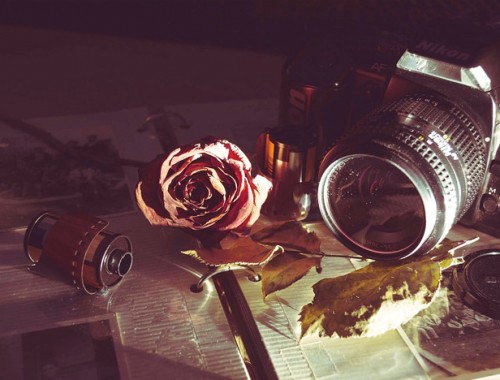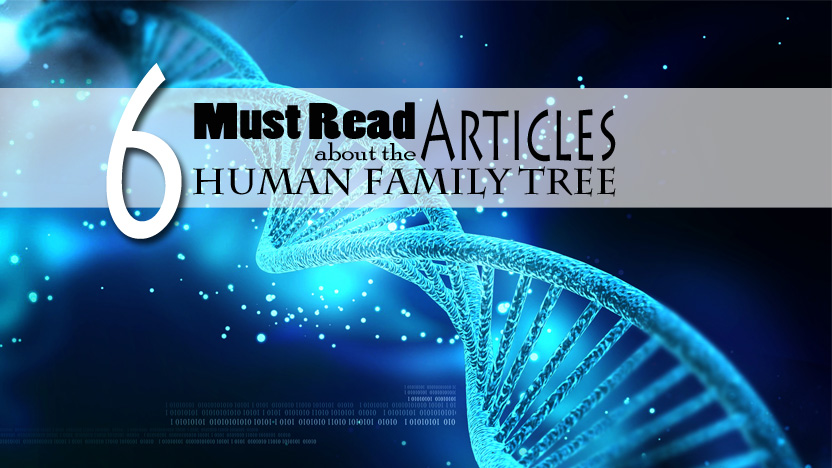We’re continuing our series on identifying clothing! Last week, we looked at identifying styles from the 1840s-50s. Now, we’re looking at the 1860s-70s: a period marked by the Civil War and Reconstruction in the United States. You might see styles you recognize if you’re familiar with the works of Gone With the Wind or other Civil War reenactments, or Alice in Wonderland.
Photography
The daguerreotype fell from favor by the 1860s, replaced by the ambrotype. These were underexposed negatives optimized for viewing, and were cheaper than daguerreotypes. While they disposed of the troublesome metallic shine on a daguerreotype, they could look dull in comparison. In turn, the ambrotype vanished, replaced by the tintype, a photo positive on a sheet of metal. These had their height in the 1860s and 70s, so if your photo is a tintype, you are likely looking at these decades.
1860s
Women’s clothing
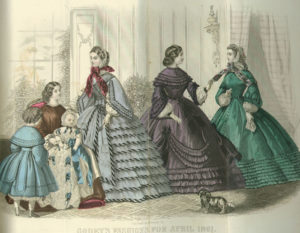 Women’s fashion could be up to a year behind European fashions. Styles in London and Paris tended to change much more quickly. Civil War-era dresses used very wide crinolines, since the desired silhouette of the later 19th century included small waists. However, skirts began to slim down around 1864, changing from the shape of a dome to a “crinolette,” which kept volume only at the back of the skirt. True bustles soon appeared after this, starting in 1869.
Women’s fashion could be up to a year behind European fashions. Styles in London and Paris tended to change much more quickly. Civil War-era dresses used very wide crinolines, since the desired silhouette of the later 19th century included small waists. However, skirts began to slim down around 1864, changing from the shape of a dome to a “crinolette,” which kept volume only at the back of the skirt. True bustles soon appeared after this, starting in 1869.
As in previous decades, hairstyles remained parted in the middle and smoothed or poofed over the ears. The roll or bun was worn low at the back of the neck. Women might wear their hair in decorative nets, especially if they were young. (While some people might call this a “snood,” this word refers to something else entirely.) Women also wore heavily trimmed bonnets with lower brims. These were made specifically as accessories.
This decade also saw the advent of “artistic dress,” a style that rejected, heavy trim, crinolines, and corsets. These dresses focused on simpler designs, looser fittings, and natural dyes. Their shape often had a vaguely medieval look, using narrow skirt silhouettes and possibly trains on the skirt. This isn’t to say they were entirely plain; hand embroidery often decorated these dresses, which were made of silk, muslin, or velvet.
Men’s clothing
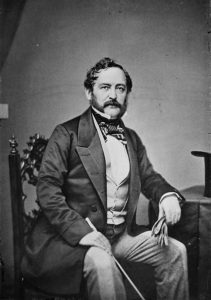 Men wore very similar fashions as in the 1950s. Single-breasted frock coats came to the knee, and men wore them for business occasions. However, the sack coat (a loose-fitting, mid-thigh coat) became more and more popular for less formal occasions. Evening dress was still a dark tailcoat, trousers, and a white cravat; this solidified over the century into our modern white tie dress.
Men wore very similar fashions as in the 1950s. Single-breasted frock coats came to the knee, and men wore them for business occasions. However, the sack coat (a loose-fitting, mid-thigh coat) became more and more popular for less formal occasions. Evening dress was still a dark tailcoat, trousers, and a white cravat; this solidified over the century into our modern white tie dress.
Overcoats began to use contrasting velvet collars, very wide lapels, and deep cuffs.
While top hats and stovepipes were popular, the bowler hat started to gain steam for informal occasions. John B. Stetson introduced the Boss of the Plains hat in 1865, which immediately became popular out West. This later became the stereotypical cowboy hat.
Civil war uniforms during 1860 -65 had three distinct styles. Union soldiers wore blue, often with lighter-colored trousers. Rank could be indicated by epaulettes (fringed shoulder pads) and stars. Many of these were made at home.
Children’s clothing
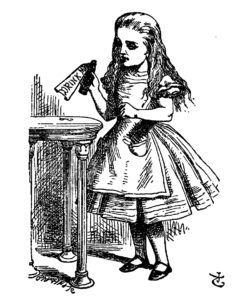
Illustration of Alice in Wonderland by Sir John Tenniel
Boys and girls both wore skirts until the age of 5 or 6. You may have to use outside records to determine the identity of a very young child in one of these photos. Boys then transitioned to jackets and trousers in simple styles. The older they got, the more their styles began to emulate a grown man’s.
Girls, on the other hand, wore skirts just below the knee with lacy pantalettes beneath. Their skirts lengthened as they aged until they “came out” into society around 16-18, when their skirts would be ankle-length or just above the ankle. Younger upper-class girls and lower-class girls and women also wore pinafores–a protective, washable apron that was open in the back. This kept their dresses clean while they played or worked.
One famous example of 1860s girlhood fashion is Alice in Wonderland, with her short skirt, pantalettes and long stockings, and pinafore.
1870s
Women’s Fashion
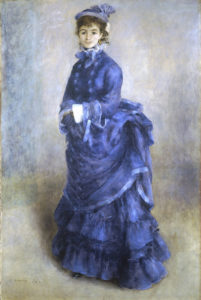
Pierre-Auguste Renoir painting of a woman wearing typical 1874 fashion.
Silhouettes in general narrowed further, completely abandoning the crinoline. Dresses featured square necklines and tight sleeves. Skirts used tiers of ruffles in the back to add volume from 1870-74. During this time, women would also secure draped overskirts over a bustle and ruffled underskirt. Women also draped overskirts in the front of their dress to create an “apron” effect.
In the later part of the decade, the silhouette shifted, with the volume in the back beginning at the hips rather than at the waist to taper off into long trains. Skirts narrowed still more, though volume remained an important feature. Evening gowns featured longer trains and required short or mid-length gloves. Women wore something similar to a choker in the style of a velvet ribbon worn high on the neck and left to trail behind.
While never worn in public, you may find photos of a tea gown. This was a flowing, high-collared dress for informal entertaining, worn without a corset. In fact, its intent was that a lady didn’t need a maid to help her put it on at all! However, this meant it was inappropriate to wear out of doors. Women also began to wear more leisure clothing, like seaside bathing dresses. These still included the bustle, and were made of fabrics that would not become transparent when wet or rise up in the water.
Women pulled their hair back and wore it higher on the crown in a knot or pile of curls to bring emphasis upward. They also wore bangs over the forehead and may have used false hair to accomplish their styles. Hats were small and accommodated these hairstyles, and may have included a veil.
Men’s clothing
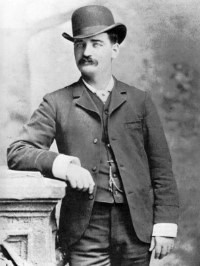
1879 photo of American lawman Bat Masterson wearing a three-piece suit, cutaway sack coat, and bowler hat.
Frock coats became shorter during this decade. Waistcoats began to see collarless styles, and also to change color. Where white had been popular before for evening wear, men began to wear darker waistcoats. Sack coats, which remained popular and began to gain more of a shape similar to the business suit of today, were cut so that the wearer could button them only at the top. Men also would press their high shirt collar points into “wings”, and wear wider neckties (ascots) fastened with a pin or jewel.
Overcoats (topcoats) featured wide lapels and contrasting collars. In colder areas, men might wear a fur-lined, full-length coat as a luxury.
While the top hat was a requirement for evening dress, men would wear bowler hats with their lounge suits and more informal attire.
Men continued to wear full-length trousers; however, they switched to tweed or wool breeches for outdoor activities like hiking. While fabric continued to match the waistcoat and sack coat in the style of a “ditto suit,” checkered fabric for trousers also became popular in 1870-1875. Blue jeans as we know them today appeared in San Francisco in 1873. Gold-seekers loved these for their pockets and sturdy fabric.
Children’s clothing
As in previous decades, children wore dresses until age 5 or 6, when they began to emulate their parents. You might be able to determine age by how similar a child’s clothing is to their parents’; the older a boy, the more his clothing would resemble his father’s. A girl’s age can be indicated by the length of her skirt: small girls wore skirts above the knee; 10-12 year-olds wore knee-length; 12-15 slowly lengthened to mid-calf; and 16-17 year-olds wore dresses just above the ankle.
Next week, we’ll be looking at the 1880s-90s, the latter end of Victorian fashion.

